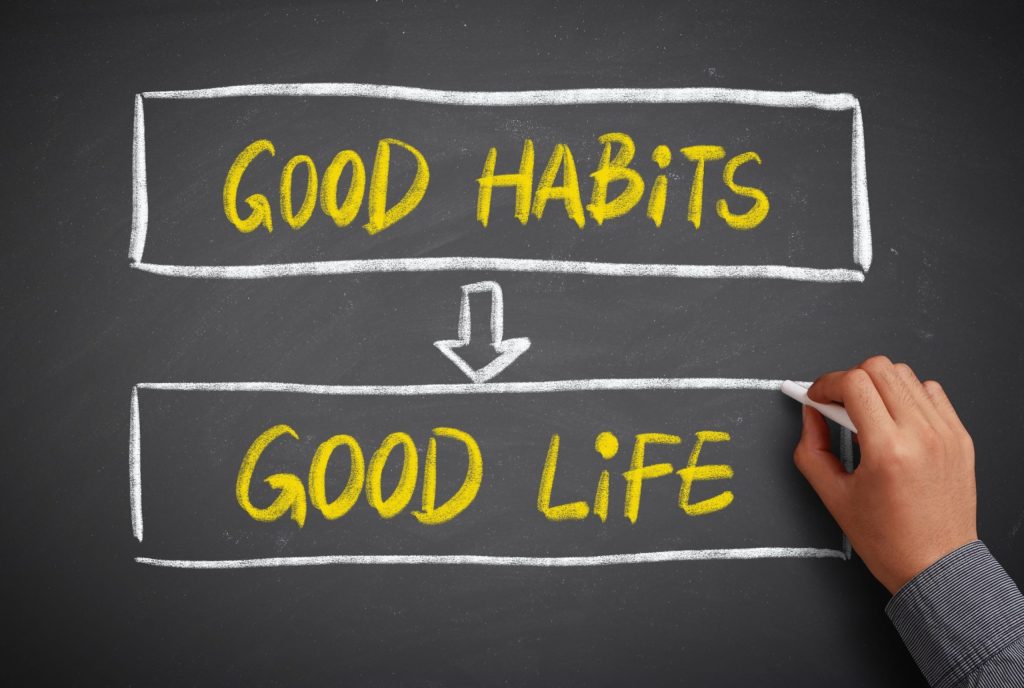
So I’m sure by now you may be thinking, “wow, this is a lot of work! I’m supposed to do it every day for the rest of my life?” Well, kind of…
Here’s the thing – if you are disciplined in building a practice around your fulfillment equation for any decent length of time, you will discover that it actually becomes an ingrained habit! In this way, you can become tuned into it without always making a conscious effort. It simply turns into the way you live on a day to day basis.
How Daily Habits Turn Into Lifelong Fulfillment
In James Clear’s pivotal book, Atomic Habits, he writes: “You do not rise to the level of your goals, you fall to the level of your systems. Your goal is your desired outcome, your system is the collection of daily habits”.
In the next section of the Fulfillment Equation, we’ll dive into goals and outcomes by identifying your long-term dreams and linking them back into your equation. However, the practice you establish in daily living through your unique fulfillment equation becomes the “collection of daily habits” that is so foundational. This is because it nurtures the mindset, focus and sense of satisfaction in the present that will launch your ability to pursue your dreams in the future. The system is the blocks of time that become the collection of daily habits and those blocks are intentionally chosen based on what brings you joy. The hours become days, the days become weeks, the weeks become years. This is how you evolve to be the architect of your own fulfillment throughout your lifetime. One hour at a time. It’s that simple.

What Parts of the Daily Practice Can Become Ingrained?
At its core, the unique equation process is powerful because it fosters two main things: a healthy mindset and deliberate focus. With practice, both can become more natural. However, I would suggest that one takes a bit more ongoing effort than the other. In my experience, the daily practices around mindset are non-negotiable. This includes, amongst other things, the morning intention setting, finding flow throughout the day and the evening gratitude practice (covered in step 3: Putting Your Equation Into Practice). At the same time, when it comes to daily efforts around focus, I have found that, with practice, this can eventually run itself. This includes the detail around exactly what is in your daily equation. To use an airplane analogy, the mindset piece is one where I actively have my hands on the steering wheel whereas the focus piece is the one I can often put on autopilot now that I’ve flown the route manually many times over.
When I first started using my equation on a daily basis, I was diligent about writing it down and tracking it for about 9 months (with a few gaps here and there). After that, it was not as necessary to actually write it down anymore because I could almost follow along by memory. Flexing my week (step 4) and the analysis and adjustment (step 5) became something I could do easily in my own head, without needing to document it. As long as you are feeling fulfilled and content with the way you are spending your time, you can lean on the habits you’ve built with practice to keep you chugging along.

When To Switch Off Autopilot
Even pilots need to intervene from time to time. Perhaps things were going along smoothly flying at a certain level of altitude and then all of a sudden there’s turbulence. In this case, it may be necessary to manually take over to move into a smoother path before putting on the autopilot again. You can also think of this like cruise control on your car. Sometimes you need to take over, adjust speed, change lanes.
Staying in touch with your feelings will help you know when you need to take the wheel. Perhaps you are feeling like something is missing or you aren’t spending enough time on something that is really important to you. Perhaps the equation that was working before isn’t doing the trick anymore. Perhaps something has altered in your environment that necessitates adjusting the balance in your equation. These are all good times to go back to actually documenting, reviewing, analyzing and adjusting your equation on a daily basis. Remember that it is a tool for you to lean on when you need it.
One example of where I will pull out of autopilot and actively document my equation is on periods of vacation. It sounds completely counterintuitive to do something that could be considered a bit of a chore during a period of relaxation, but it works in exactly the opposite way. Being deliberate about how I want to spend my precious vacation time and then following through while retaining a great deal of flexibility actually allows for the relaxation. This is because it aligns my expectations with my reality. How often have you left a period of vacation feeling unfulfilled? It is probably because there was a gap between what you were expecting and how you actually spent your time. Leaning on the practice of your equation can put you in the right mindset and help you be intentional in a way that allows you to enjoy the time off to the fullest.

Checking in on the Design From Time to Time
There are also times when you may need to revisit the underlying architecture of your equation.
The activity of brainstorming and organizing your word cloud (step 1) is primarily done at the beginning when you are forming your initial unique fulfillment equation. It challenges you to identify all of the ways that you both want and have to spend your time, and then cluster them into themes. These clusters become the blocks of your equation. If you’ve done a decent job of this initial cluster identification, you probably don’t need to spend much time on this step routinely.
With that said, it’s worth checking in on your clusters from time to time (maybe once every year or two). You may find that some of the activities within the clusters have changed. For example, my initial brainstormed list of activities in a cluster I called Friends included things that are no longer relevant, either because my kids grew or routine get-togethers dissolved over time. It’s a good opportunity to make sure there are new activity options replenishing that cluster. You may also find that some clusters can be rearranged. For example, over time, I was able to transform my work to be more in line with my interests. So where I had two distinct clusters previously labeled as “Interests” and “Purpose”, I would now consider combining them into one.
Overall, you will likely find that there is a great deal of consistency in your word cloud over time. In taking a moment to review my own, 5 years after creating it, I’m not surprised to notice that it is still 90% accurate for my life today. I would change some of the detailed activities, but the overall structure remains sound.
Similar to your word cloud, Building your Equation (step 2) is an activity that you generally do once in the beginning. After that, it is very little work to make tweaks that evolve your equation over time. Changes will tend to be made more in how you allocate your weekly equation across days of the week, than they will to the equation as a whole. This is covered in Step 5: Analysis and Adjustment. With that said, if you experience a significant life change, such as having kids or entering retirement, you will likely want to redesign your equation from scratch in order to give yourself the space to design something with a fresh set of eyes.

Where Do I Go From Here?
The point is that once you’ve done the initial work and spent the time needed to build the valuable habits around your fulfillment equation, there is definitely an aspect of “set it and forget it” that can take over. You’ll know you’re really practiced when you can’t really remember how you lived before you approached daily living this way.
In the next section, we’ll lift out of the present and look toward the future as we understand the process for identifying and pursuing your long-term dreams. This will help to give some exciting direction to daily living.
Read Next Article: Your Personal Strategy: Step 1 – Creating A Vision




